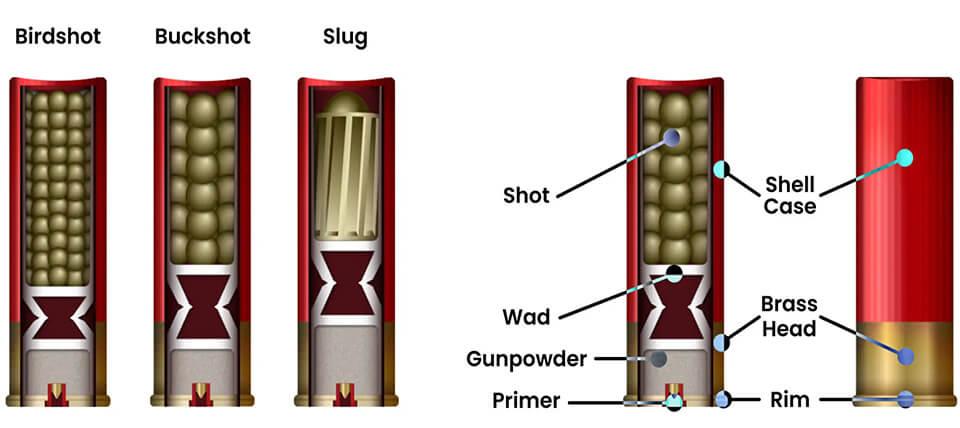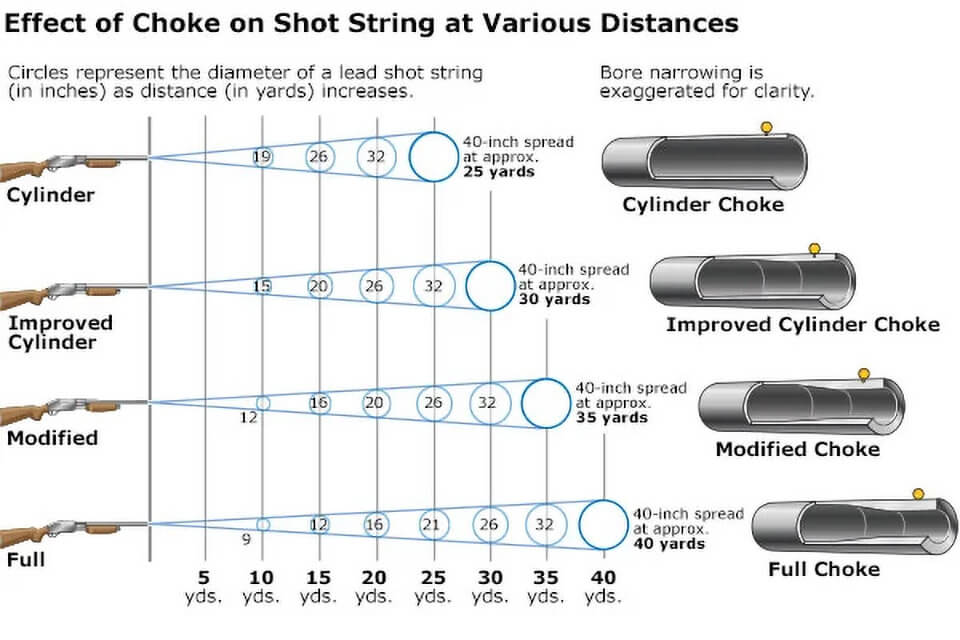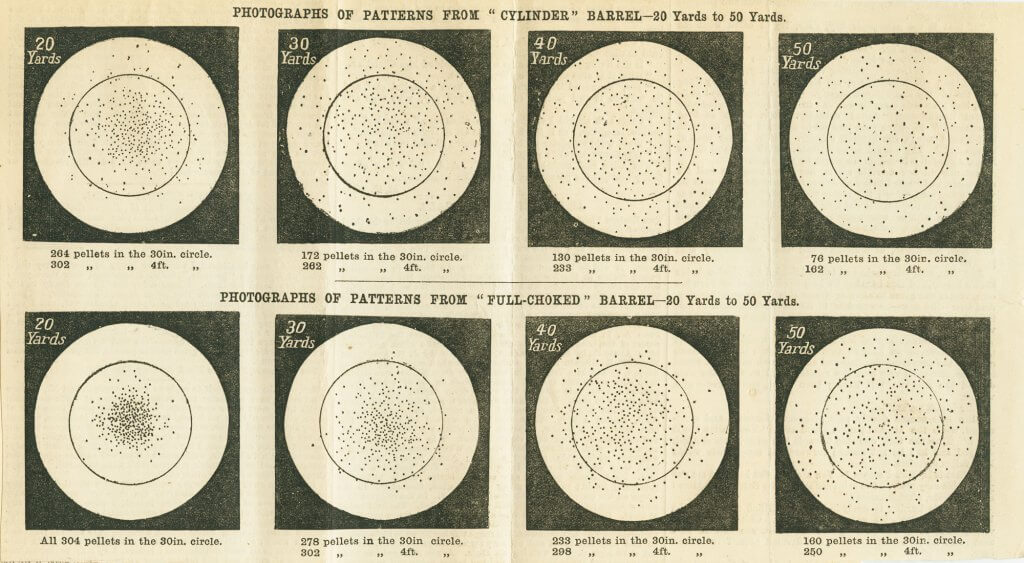“What the heck?! I know I hit that bird, no question!” is a familiar complaint in the hunt field and on the clay course. Often, a shooter assumes she didn’t have the correct sight picture, and consequently, did something wrong. In reality, the sight picture was absolutely correct, but the shot load was incorrect for the quarry or clay presentation. This month, we geek out a bit on what it takes to drop our target, clay or feathered and how to stack the deck in our favor.
Dropping the Facts on “Drop Shot”
Modern technology is incredible. Over the years, we have evolved from beating rocks to fashioning a spearpoint to high-powered, ballistic marvels. Scatter guns or shotguns are no stranger to this evolution. We’ve all seen that scene in an old Western or war movie where the guy is sitting around a campfire late at night pouring lead into a mold to fashion a roundball for his gun. Not only is that painstakingly laborious, but it’s also super time consuming.
This gave way to the “modern” invention of a shot tower, wherein the pellets were formed by good old gravity. The shot tower was of brick construction, measuring 10 stories or more, and had a vat in the top to hold molten lead. The lead flowed through a pan punched with numerous holes that was struck several times a second to release the lead in drops. As the lead gained velocity due to gravity, it became rounded, thanks to the surface tension from the air. The bottom of the tower held a water tank that cushioned the fall and cooled the pellets. The pellets were then sorted by size and any that didn’t pass inspection were tossed in a bucket to be smelted again.

I’ve never personally seen a shot tower, but I did find this article on the history of shot towers, courtesy of Minnesota Trap Association. Turns out there is one still standing right here in Virginia! There are actually several still around and the last one to operate just shut down in 1995. That’s probably because in the 1960s, engineers realized the benefits of plastics and unibody construction while crafting a better wad. The wad in a shotshell prevents the propellants and pellets from mixing and maintains an exact amount of space to allow for a proper seal to keep gases from escaping into the shot and for shock absorption and pattern integrity of the shot.

Going Deeper
Bigger, better, faster. That describes the modern-day shot loads available down at your local sporting goods store. But do you realize that not all shot is 1) created equally and 2) appropriate in every application?
For example, you would never use #2 shot on quail and likewise, would not want to use #8 shot on ducks. Why? Well, that is exactly where we get into pellet penetration versus pattern density.

Pellet penetration is the depth that a pellet can travel, and pattern density is the number of pellets that hit said target. So, which is more important? BOTH! They are joined at the hip and work hand-in-hand with one another. This is also where your head will start to swim a bit. Whether you’re shooting clays or feathers, you need a dense pattern to land a solid kill shot BUT you need a big enough pattern to not cripple or miss your target. Every club has more than one rabbit target lying on the ground with a couple of BB holes, but it was never counted as a “X” since the field judge never saw a piece break off. This is a prime example of poor choke/shot load selection. The easiest way to make sure you’re putting enough BBs in the air is to pattern your chosen shot load with the desired choke combination.

In researching this topic, I found the following to be one of the most concise explanations on pellet performance, “When a lead pellet impacts the target, the pellet deforms slightly, increasing its frontal area and transferring energy to the target more quickly … at the expense of reduced penetration.” An NRA staff article continues “the lethality of shotgun pellets is directly related to pattern quality.” In other words, always shoot a better shell. While larger pellets offer better penetration into your target, the smaller pellets can put more pellets in the “kill zone.” What in the world does all of this mean to you? It means know what works best for your gun and your target.
Time to Pattern
If you haven’t patterned your gun yet, what are you waiting for? It’s very easy and requires just a big sheet of plain paper, your shotgun, chokes and test shells. Your gun will not like every brand of ammo, and it will shoot some loads better than others. Actually, while I’m thinking about it, grab several sheets of plain paper; let’s do multiple tests. If you have a double barrel, you will want to test each barrel independently.


The designated pattern test distance is anywhere from 20 yards to 50 yards. The game you play or quarry you chase will dictate the distance. I like to mark the center of the paper, so I have something to look at when I test. Shoot that mark and then draw a 30-inch circle around the mark counting the number of pellets within the circle. You also want to take note of the spread or pattern density. Does the pattern provide ample coverage or is it too narrow, possibly leading to a miss or crippled bird? Are there big “holes” in your pattern meaning your target will easily slip through unscathed?
Another way to test different ammo is with gel. I don’t recommend this type of testing though, as it’s cost prohibitive and labor intensive and really only beneficial when sorting out if you should shoot steel over tungsten versus lead, etc. Clear Ballistics sells a clear gel that you bake in a mold. They also have different styles of premade molds including birds, beasties, etc. There are plenty of videos on YouTube if you’re curious as to how these different shot loads measure up so save your money and just Google the results.
To Choke or Not to Choke
Syren shotguns all come with high performance chokes. The type of chokes depends on the intended application of the gun. For the field guns, Guerini models come with nickel-plated SelectaChokes and Fabarm guns with INNER HP chokes. All of these are flush set, since the name of the game is to get on your quarry in any manner of cover before it escapes. Extended chokes are best left in the clay games.
The 12-gauge sporting models are equipped with either EXIS HP or MAXIS competition chokes. The all-new Grayce Invictus is set up with an amazing set of grade 5 titanium chokes that are ridiculously light and true works of art. And yes, you read that correctly. Grayce brings the coveted technology of Invictus system to the Syren line just for us women.
Syren Fabarms are amazing shotguns – as they have hyperbolic chokes, meaning the pattern opens up more efficiently upon exiting the muzzle in a smooth and consistent pattern. This limits deformity and retains the integrity of the pattern. As a matter of fact, the Tri-Bore system in Fabarm’s is a modern marvel. Pellets exit the chamber and receive only minimal constriction to allow for the barrel diameter. Most manufacturers build the barrel with the forcing cone right out of the chamber, causing harsh deformation and radical redistribution of the pellets. Fabarm places the forcing cone just before the choke to allow for a smoother transition that maintains the pellet integrity creating less recoil and spot on patterns.

All Syren barrels are painstakingly bored with the most precise measurements possible to create the strongest, lightest, most well-balanced barrels on the market. Take time to pattern your gun and understand which choke(s) works best with a particular shot load. If you’re chasing that next punch on your competition circuit, know which clay presentations require a skeet choke and #9 shot or a light modified choke and #7.5 shot. Same thing for the hunt field, even more so! You want to be able to land a solid hit when your target is feathered.
For field trials, I use the Syren L4S 12-gauge with a Fiocchi 1-1/4-ounce load #8 shot at 1330fps and a wide-open skeet choke. Why? The trial is a shoot to retrieve timed event and every second counts, so I don’t want long retrieves, and I absolutely don’t want to have to use a second shell because that brings a penalty. I have to drop birds fast and close. This set up gives me a great big net of BBs to bag my birds right at the flush.
Have you found a crushing combination for your Syren? We would love to hear about it! Let us know your favorite choke and shot load for your particular presentation, clay or feathered, better yet drop us a pic on our Syren Owners group on Facebook.
Kate Ahnstrom, owner of Virginia Shooting Sports, is a certified, professional instructor of the Paragon School of Sporting. She has dedicated her life to sharing her passion for the outdoors and diversifying the dynamics on the clay course and the hunt field. Her tireless dedication to her students’ success is obvious in each and every lesson. Kate is on the pro staff for Syren, the resident pro at Orapax Hunting Preserve and the Preserve at Dundee, department editor for “Woods and Waters” magazine and field staff member of the Sisterhood of the Outdoors. She and her husband, Mike, enjoy their small farm in central Virginia where they have a menagerie of animals and plenty of room to train and work their beloved GSPs. Kate loves getting behind the barrel of her Syren Tempio Sporting in 20 gauge for all things clay and feathered. View all posts by Kate Ahnstrom